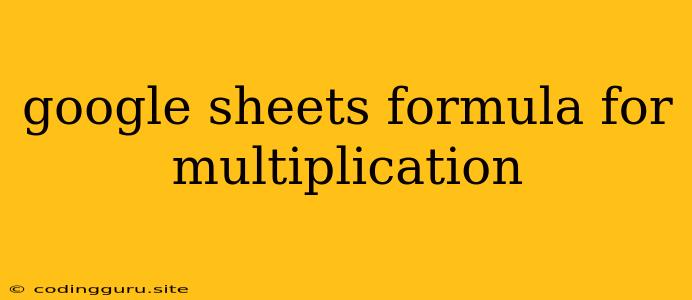Mastering Multiplication in Google Sheets: A Comprehensive Guide to Formulas
Google Sheets is a powerful tool for data management and analysis, and mastering formulas is key to unlocking its full potential. Multiplication is a fundamental mathematical operation, and Google Sheets offers several ways to perform it efficiently. Whether you're calculating product costs, analyzing financial data, or simply working with numbers, this guide will equip you with the knowledge to effortlessly multiply values in your spreadsheets.
Understanding the Basics: The MULTIPLY Function
The simplest way to multiply in Google Sheets is using the MULTIPLY function. This function takes two or more arguments, representing the numbers you want to multiply, and returns their product. Here's how it works:
Syntax:
=MULTIPLY(number1, [number2, ...])
Example:
To multiply 5 by 10, use the following formula:
=MULTIPLY(5, 10)
This will return a result of 50.
Important Notes:
- The
MULTIPLYfunction can handle multiple numbers within the parentheses. For example,=MULTIPLY(2, 3, 4)will multiply 2 by 3 and then by 4, resulting in 24. - The
MULTIPLYfunction accepts both numbers and cell references as arguments.
Beyond the Basics: Alternative Multiplication Techniques
While the MULTIPLY function is straightforward, Google Sheets offers additional flexibility for multiplication scenarios:
-
The Asterisk Operator (*): This is the most common method for performing multiplication in spreadsheets. Simply place an asterisk between the values you want to multiply. For instance,
=A1*B1will multiply the values in cells A1 and B1. -
The SUMPRODUCT Function: The
SUMPRODUCTfunction is powerful for multiplying arrays of numbers. It multiplies corresponding elements in two or more arrays and then sums up the results.
Syntax:
=SUMPRODUCT(array1, [array2, ...])
Example:
To multiply corresponding elements in two columns (A1:A5 and B1:B5), use:
=SUMPRODUCT(A1:A5, B1:B5)
- The ARRAYFORMULA Function: This function allows you to apply a formula to an entire range of cells without having to manually drag the formula down. It can be particularly useful for multiplication operations involving arrays.
Example:
To multiply all values in column A by 2, use:
=ARRAYFORMULA(A1:A10 * 2)
Advanced Tips and Tricks
- Conditional Multiplication: You can incorporate conditional logic within your
MULTIPLYfunction using theIFfunction. This enables you to multiply values only if a certain condition is met.
Example:
To multiply cell A1 by cell B1 only if the value in cell C1 is greater than 10:
=IF(C1>10, MULTIPLY(A1, B1), 0)
- Combining Multiplication with Other Functions: You can integrate the
MULTIPLYfunction with other mathematical functions likeSUM,AVERAGE,MIN, andMAXto perform more complex calculations.
Example:
To calculate the total cost of items in a list, multiplying the price per item by the quantity, use:
=SUMPRODUCT(PriceRange, QuantityRange)
Conclusion
Google Sheets offers a range of methods for performing multiplication, each with its own advantages and use cases. From the simple MULTIPLY function to more advanced techniques like SUMPRODUCT and ARRAYFORMULA, you can find the most efficient approach for any situation. By mastering these formulas, you can unleash the full power of Google Sheets for your data manipulation and analysis needs.
